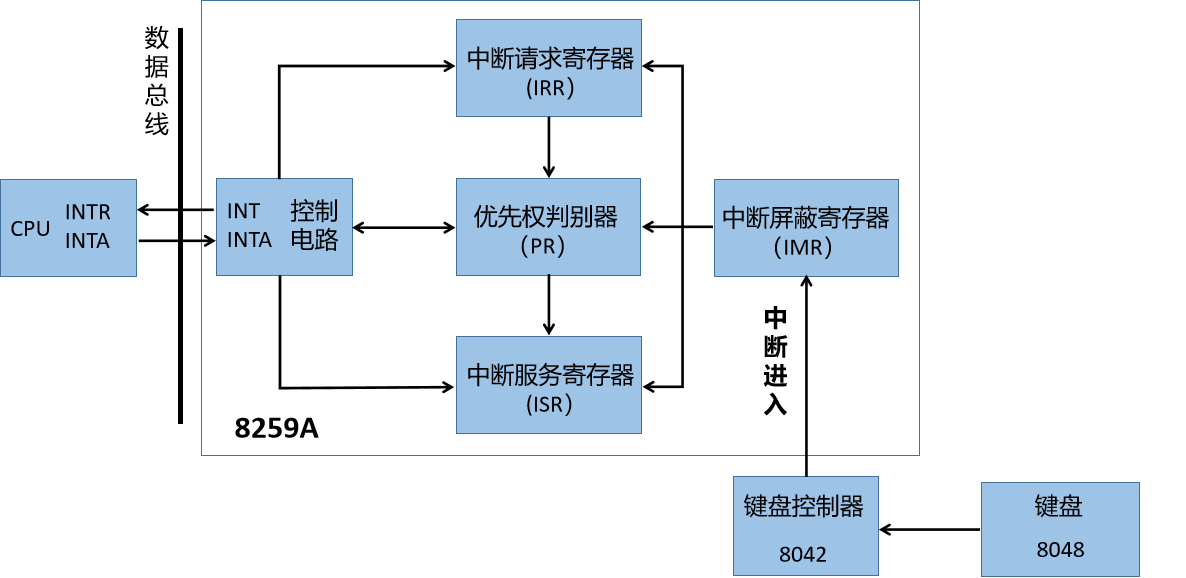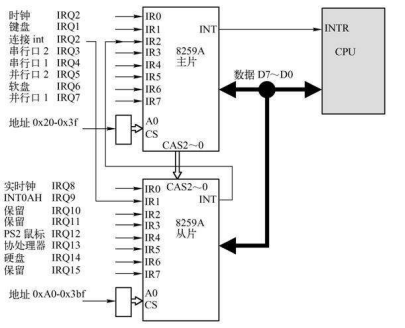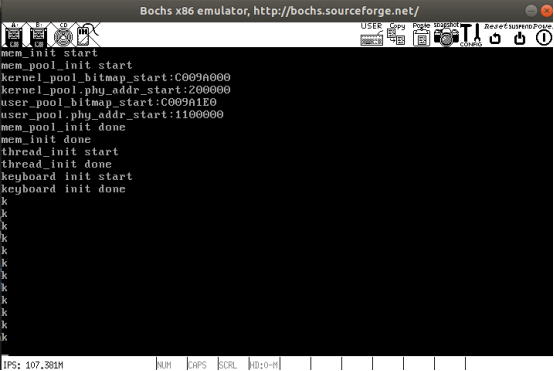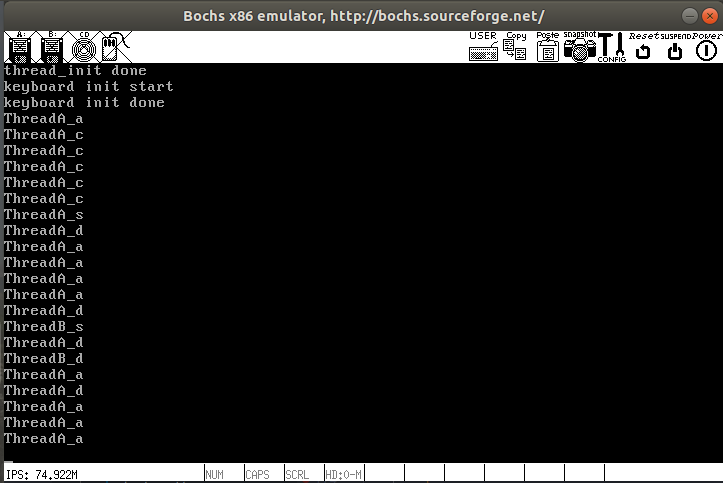目录
一、前景回顾
二、实现键盘输入的中断函数
三、编写键盘驱动
四、实现环形输入缓冲区
五、运行测试
一、前景回顾
上一回我们完成了锁的实现,并且利用锁优化了终端输出函数。这一回我们来实现键盘的输入,为后面的用户交互功能打好基础。
二、实现键盘输入的中断函数
首先我们需要知道键盘是属于外设,所以对应的中断属于外部中断。在讲中断那一章节时,我们知道了外部中断的处理流程,不过对于键盘的输入中断,还需要增加一点点东西。

8048是键盘上的芯片,其主要任务就是监控哪个键被按下,一旦有按键信息,8048就将按键信息传递给键盘控制器8042(8042通常是Intel 8042或兼容芯片,集成在主机内部的主板上),再由8042发送中断信号给8259A。最重要的一点是,键盘的中断号。

我们可以看到键盘对应的是IR1口,这个是硬件上决定的,所以我们无法更改。除此之外,在我们的程序中,我们将IR0口的中断号设置为0x20,后面依次递增,所以我们可以知道键盘的中断号为0x21。这里我们不管按键信息如何,我们只需要知道一旦有按键按下,就会有中断触发,所以我们尝试写一下按键的中断处理函数。
在project/kernel目录下新建keyboard.c、keyboard.h文件,除此之外还需要修改interrupt.c文件。

1 #include "keyboard.h"
2 #include "print.h"
3 #include "interrupt.h"
4 #include "io.h"
5 #include "global.h"
6 #include "stdint.h"
7
8 #define KBD_BUF_PORT 0x60
9
10 static void intr_keyboard_handler(void)
11 {
12 put_str("k\n");
13 inb(KBD_BUF_PORT);
14 }
15
16 /*键盘初始化*/
17 void keyboard_init(void)
18 {
19 put_str("keyboard init start\n");
20 register_handler(0x21, intr_keyboard_handler);
21 put_str("keyboard init done\n");
22 }
keyboard.c

1 #ifndef __KERNEL_KEYBOARD_H
2 #define __KERNEL_KEYBOARD_H
3
4 void keyboard_init(void);
5 static void intr_keyboard_handler(void);
6 #endif
keyboard.h

1 ...
2
3 /* 初始化可编程中断控制器8259A */
4 static void pic_init(void) {
5 /* 初始化主片 */
6 outb (PIC_M_CTRL, 0x11); // ICW1: 边沿触发,级联8259, 需要ICW4.
7 outb (PIC_M_DATA, 0x20); // ICW2: 起始中断向量号为0x20,也就是IR[0-7] 为 0x20 ~ 0x27.
8 outb (PIC_M_DATA, 0x04); // ICW3: IR2接从片.
9 outb (PIC_M_DATA, 0x01); // ICW4: 8086模式, 正常EOI
10
11 /* 初始化从片 */
12 outb (PIC_S_CTRL, 0x11); // ICW1: 边沿触发,级联8259, 需要ICW4.
13 outb (PIC_S_DATA, 0x28); // ICW2: 起始中断向量号为0x28,也就是IR[8-15] 为 0x28 ~ 0x2F.
14 outb (PIC_S_DATA, 0x02); // ICW3: 设置从片连接到主片的IR2引脚
15 outb (PIC_S_DATA, 0x01); // ICW4: 8086模式, 正常EOI
16
17 /*只打开键盘中断*/
18 outb (PIC_M_DATA, 0xfd);
19 outb (PIC_S_DATA, 0xff);
20
21 put_str("pic_init done\n");
22 }
23
24 ...
interrupt.c
最后编译运行,可以看到我们一旦按下按键,屏幕便会打印信息,而且释放按键也会打印信息。当然这是后面需要讲解的内容,总之到现在,我们已经成功实现了按键的中断处理函数。

三、编写键盘驱动
现在来说说为什么按下按键和释放按键都会触发中断。其实这是硬件所决定的,一个键的状态要么是按下,要么是弹起,因此一个按键有两个编码,按键被按下时的编码是通码,按键被释放时的编码是断码。
无论是按下键或是松开键,当键的状态改变后,键盘中的8048芯片把按键对应的扫描码(通码或者断码)发送到主板上的8042芯片,由8042处理后保存在自己的寄存器中,然后向8259A发送中断信号,这样处理器便去执行键盘中断处理程序,将8042处理过的扫描码从它的寄存器中读取出来,随后将扫描码转换成对应的ASCII码。
所以我们的函数中需要自己完善这么一个映射关系,也就是扫描码到ASCII码的映射。这里就偷懒直接抄书上的,我也没有去仔细看了,总之能知道整个流程就行了。
所以进一步完善我们的keyboard.c文件如下。

1 #include "keyboard.h"
2 #include "print.h"
3 #include "interrupt.h"
4 #include "io.h"
5 #include "global.h"
6 #include "stdint.h"
7 #include "ioqueue.h"
8
9 #define KBD_BUF_PORT 0x60
10
11 /*用转移字符定义部分控制字符*/
12 #define esc '\033'
13 #define backspace '\b'
14 #define tab '\t'
15 #define enter '\r'
16 #define delete '\0177'
17
18 /*以下不可见字符一律为0*/
19 #define char_invisible 0
20 #define ctrl_l_char char_invisible
21 #define ctrl_r_char char_invisible
22 #define shift_l_char char_invisible
23 #define shift_r_char char_invisible
24 #define alt_l_char char_invisible
25 #define alt_r_char char_invisible
26 #define caps_lock_char char_invisible
27
28 /*定义控制字符的通码和断码*/
29 #define shift_l_make 0x2a
30 #define shift_r_make 0x36
31 #define alt_l_make 0x38
32 #define alt_r_make 0xe038
33 #define alt_r_break 0xe0b8
34 #define ctrl_l_make 0x1d
35 #define ctrl_r_make 0xe01d
36 #define ctrl_r_break 0xe09d
37 #define caps_lock_make 0x3a
38
39 /*定义以下变量记录相应键是否按下的状态*/
40 static bool ctrl_status, shift_status, alt_status, caps_lock_status, ext_scancode;
41
42
43 /*以通码make_code为索引的二维数组*/
44 static char keymap[][2] = {
45 /*扫描码未与shift组合*/
46 /* 0x00 */ {0, 0},
47 /* 0x01 */ {esc, esc},
48 /* 0x02 */ {'1', '!'},
49 /* 0x03 */ {'2', '@'},
50 /* 0x04 */ {'3', '#'},
51 /* 0x05 */ {'4', '$'},
52 /* 0x06 */ {'5', '%'},
53 /* 0x07 */ {'6', '^'},
54 /* 0x08 */ {'7', '&'},
55 /* 0x09 */ {'8', '*'},
56 /* 0x0A */ {'9', '('},
57 /* 0x0B */ {'0', ')'},
58 /* 0x0C */ {'-', '_'},
59 /* 0x0D */ {'=', '+'},
60 /* 0x0E */ {backspace, backspace},
61 /* 0x0F */ {tab, tab},
62 /* 0x10 */ {'q', 'Q'},
63 /* 0x11 */ {'w', 'W'},
64 /* 0x12 */ {'e', 'E'},
65 /* 0x13 */ {'r', 'R'},
66 /* 0x14 */ {'t', 'T'},
67 /* 0x15 */ {'y', 'Y'},
68 /* 0x16 */ {'u', 'U'},
69 /* 0x17 */ {'i', 'I'},
70 /* 0x18 */ {'o', 'O'},
71 /* 0x19 */ {'p', 'P'},
72 /* 0x1A */ {'[', '{'},
73 /* 0x1B */ {']', '}'},
74 /* 0x1C */ {enter, enter},
75 /* 0x1D */ {ctrl_l_char, ctrl_l_char},
76 /* 0x1E */ {'a', 'A'},
77 /* 0x1F */ {'s', 'S'},
78 /* 0x20 */ {'d', 'D'},
79 /* 0x21 */ {'f', 'F'},
80 /* 0x22 */ {'g', 'G'},
81 /* 0x23 */ {'h', 'H'},
82 /* 0x24 */ {'j', 'J'},
83 /* 0x25 */ {'k', 'K'},
84 /* 0x26 */ {'l', 'L'},
85 /* 0x27 */ {';', ':'},
86 /* 0x28 */ {'\'', '"'},
87 /* 0x29 */ {'`', '~'},
88 /* 0x2A */ {shift_l_char, shift_l_char},
89 /* 0x2B */ {'\\', '|'},
90 /* 0x2C */ {'z', 'Z'},
91 /* 0x2D */ {'x', 'X'},
92 /* 0x2E */ {'c', 'C'},
93 /* 0x2F */ {'v', 'V'},
94 /* 0x30 */ {'b', 'B'},
95 /* 0x31 */ {'n', 'N'},
96 /* 0x32 */ {'m', 'M'},
97 /* 0x33 */ {',', '<'},
98 /* 0x34 */ {'.', '>'},
99 /* 0x35 */ {'/', '?'},
100 /* 0x36 */ {shift_r_char, shift_r_char},
101 /* 0x37 */ {'*', '*'},
102 /* 0x38 */ {alt_l_char, alt_l_char},
103 /* 0x39 */ {' ', ' '},
104 /* 0x3A */ {caps_lock_char, caps_lock_char}
105 };
106
107 /*键盘中断处理程序*/
108 static void intr_keyboard_handler(void)
109 {
110 bool ctrl_down_last = ctrl_status;
111 bool shift_down_last = shift_status;
112 bool caps_lock_last = caps_lock_status;
113
114
115 bool break_code;
116 uint16_t scancode = inb(KBD_BUF_PORT);
117
118 /*若扫描码scancode是以e0开头的,表示此键的按下将产生多个扫描码
119 所以马上结束此次中断处理函数,等待下一个扫描码进入*/
120 if (scancode == 0xe0) {
121 ext_scancode = true;
122 return;
123 }
124
125 /*如果赏赐是以0xe0开头的,将扫描码合并*/
126 if (ext_scancode) {
127 scancode = ((0xe00) | scancode);
128 ext_scancode = false;
129 }
130
131 break_code = ((scancode & 0x0080) != 0);
132 if (break_code) {
133 uint16_t make_code = (scancode &= 0xff7f); //多字节不处理
134 if(make_code == ctrl_l_make || make_code == ctrl_r_make) {
135 ctrl_status = false;
136 }
137 else if (make_code == shift_l_make || make_code == shift_r_make) {
138 shift_status = false;
139 }
140 else if (make_code == alt_l_make || make_code == alt_r_make) {
141 alt_status = false;
142 }
143 return;
144 }
145 else if((scancode > 0x00 && scancode < 0x3b) || (scancode == alt_r_make) || (scancode == ctrl_r_make)) {
146 bool shift = false; //先默认设置成false
147 if ((scancode < 0x0e) || (scancode == 0x29) || (scancode == 0x1a) || \
148 (scancode == 0x1b) || (scancode == 0x2b) || (scancode == 0x27) || \
149 (scancode == 0x28) || (scancode == 0x33) || (scancode == 0x34) || \
150 (scancode == 0x35))
151 {
152 if (shift_down_last) {
153 shift = true;
154 }
155 } else {
156 if (shift_down_last && caps_lock_last) {
157 shift = false; //效果确实是这样子的 我试了一下
158 }
159 else if(shift_down_last || caps_lock_last) {
160 shift = true; //其中任意一个都是大写的作用
161 }
162 else shift = false;
163 }
164
165 uint8_t index = (scancode & 0x00ff);
166 char cur_char = keymap[index][shift];
167
168 put_char(cur_char);
169 }
170 return;
171 }
172
173
174 /*键盘初始化*/
175 void keyboard_init(void)
176 {
177 put_str("keyboard init start\n");
178 register_handler(0x21, intr_keyboard_handler);
179 put_str("keyboard init done\n");
180 }
keyboard.c

此时可以发现,我们在键盘上按下键,屏幕上能相应地输出字符。
四、实现环形输入缓冲区
虽然我们已经实现了键盘驱动,但是目前能实现的功能仅仅是在屏幕上输出我们所按下的按键,但是并没有什么实用的地方。我们在键盘上操作是为了能和系统进行交互,而交互过程一般都是键入各种shell命令,然后shell解析并且执行。
所以我们需要实现一个缓冲区,在按键的中断处理函数中将输入的按键信息保存在缓冲区中,将来实现的shell进程在该缓冲区中读取数据并且输出到屏幕上,等到我们按下了回车后,就将前面读取到的字符解析去处理。虽然我们还没有实现shell进程,但是我们可以新建线程来读取数据,测试缓冲区的功能。
所以下面的代码便是实现缓冲区,在project/kernel目录下新建ioqueue.c和ioqueue.h文件。

1 #include "ioqueue.h"
2 #include "interrupt.h"
3 #include "global.h"
4 #include "debug.h"
5 #include "thread.h"
6 #include "stdbool.h"
7 #include "stddef.h"
8
9 /*初始化io队列ioq*/
10 void ioqueue_init(struct ioqueue *ioq)
11 {
12 lock_init(&ioq->lock);
13 ioq->consumer = ioq->producer = NULL;
14 ioq->head = ioq->tail = 0; /*队列的首尾指针都指向缓冲区数组的第0个位置*/
15 }
16
17 /*返回pos在缓冲区的下一个位置*/
18 static int32_t next_pos(int32_t pos)
19 {
20 return ((pos + 1) % bufsize);
21 }
22
23 /*判断队列是否已满*/
24 bool ioq_full(struct ioqueue *ioq)
25 {
26 //return ((ioq->head + 1) % bufsize == ioq->tail) ? true : false;
27 ASSERT(intr_get_status() == INTR_OFF);
28 return next_pos(ioq->head) == ioq->tail;
29 }
30
31 /*判断队列是否为空*/
32 bool ioq_empty(struct ioqueue *ioq)
33 {
34 ASSERT(intr_get_status() == INTR_OFF);
35 return ioq->head == ioq->tail;
36 }
37
38 /*使当前生产者或消费者在此缓冲区上等待*/
39 static void ioq_wait(struct task_struct **waiter)
40 {
41 ASSERT(*waiter == NULL && waiter != NULL);
42 *waiter = running_thread();
43 thread_block(TASK_BLOCKED);
44 }
45
46 /*唤醒waiter*/
47 static void wakeup(struct task_struct **waiter)
48 {
49 ASSERT(*waiter != NULL);
50 thread_unblock(*waiter);
51 *waiter = NULL;
52 }
53
54
55 /*消费者从ioq队列中获取一个字符*/
56 char ioq_getchar(struct ioqueue *ioq)
57 {
58 ASSERT(intr_get_status() == INTR_OFF);
59
60 while (ioq_empty(ioq)) {
61 lock_acquire(&ioq->lock);
62 ioq_wait(&ioq->consumer);
63 lock_release(&ioq->lock);
64 }
65
66 char byte = ioq->buf[ioq->tail];
67 ioq->tail = next_pos(ioq->tail);
68
69 if (ioq->producer != NULL) {
70 wakeup(&ioq->producer);
71 }
72 return byte;
73 }
74
75
76 /*生产者往ioq队列中写入一个字符byte*/
77 void ioq_putchar(struct ioqueue *ioq, char byte)
78 {
79 while (ioq_full(ioq)) {
80 lock_acquire(&ioq->lock);
81 ioq_wait(&ioq->producer);
82 lock_release(&ioq->lock);
83 }
84 ioq->buf[ioq->head] = byte;
85 ioq->head = next_pos(ioq->head);
86
87 if (ioq->consumer != NULL) {
88 wakeup(&ioq->consumer);
89 }
90 }
ioqueue.c

1 #ifndef __KERNEL_IOQUEUE_H
2 #define __KERNEL_IOQUEUE_H
3 #include "sync.h"
4 #include "stdint.h"
5
6 #define bufsize 64
7
8 /*环形队列*/
9 struct ioqueue {
10 /*生产者消费问题*/
11 struct lock lock;
12 struct task_struct *producer;
13 struct task_struct *consumer;
14 char buf[bufsize];
15 int32_t head;
16 int32_t tail;
17 };
18
19 void ioq_putchar(struct ioqueue *ioq, char byte);
20 char ioq_getchar(struct ioqueue *ioq);
21 static void wakeup(struct task_struct **waiter);
22 static void ioq_wait(struct task_struct **waiter);
23 bool ioq_empty(struct ioqueue *ioq);
24 bool ioq_full(struct ioqueue *ioq);
25 static int32_t next_pos(int32_t pos);
26 void ioqueue_init(struct ioqueue *ioq);
27
28 #endif
ioqueue.h
五、运行测试
上面我们已经实现了环形输入缓冲区,接下来我们在main函数中新建两个线程,这两个线程不停地从缓冲区中一个字节一个字节地取数据,如果没有便阻塞,直到缓冲区中又有数据。除此之外还需要修改interrupt.c文件,我们前面只开启了键盘中断,现在加入线程调度,所以需要开启时钟中断。修改的代码一并如下:

1 ...
2
3 /* 初始化可编程中断控制器8259A */
4 static void pic_init(void) {
5 /* 初始化主片 */
6 outb (PIC_M_CTRL, 0x11); // ICW1: 边沿触发,级联8259, 需要ICW4.
7 outb (PIC_M_DATA, 0x20); // ICW2: 起始中断向量号为0x20,也就是IR[0-7] 为 0x20 ~ 0x27.
8 outb (PIC_M_DATA, 0x04); // ICW3: IR2接从片.
9 outb (PIC_M_DATA, 0x01); // ICW4: 8086模式, 正常EOI
10
11 /* 初始化从片 */
12 outb (PIC_S_CTRL, 0x11); // ICW1: 边沿触发,级联8259, 需要ICW4.
13 outb (PIC_S_DATA, 0x28); // ICW2: 起始中断向量号为0x28,也就是IR[8-15] 为 0x28 ~ 0x2F.
14 outb (PIC_S_DATA, 0x02); // ICW3: 设置从片连接到主片的IR2引脚
15 outb (PIC_S_DATA, 0x01); // ICW4: 8086模式, 正常EOI
16
17 /*打开键盘和时钟中断*/
18 outb (PIC_M_DATA, 0xfc);
19 outb (PIC_S_DATA, 0xff);
20
21 put_str("pic_init done\n");
22 }
23
24 ...
interrupt.c

1 #include "print.h"
2 #include "init.h"
3 #include "memory.h"
4 #include "thread.h"
5 #include "list.h"
6 #include "interrupt.h"
7 #include "console.h"
8 #include "ioqueue.h"
9 #include "keyboard.h"
10
11 void k_thread_a(void *arg);
12 void k_thread_b(void *arg);
13
14 int main(void)
15 {
16 put_str("HELLO KERNEL\n");
17 init_all();
18 thread_start("k_thread_a", 31, k_thread_a, "ThreadA_");
19 thread_start("k_thread_b", 8, k_thread_b, "ThreadB_");
20 intr_enable();
21 while(1);
22 }
23
24 /*在线程中运行的函数k_thread_a*/
25 void k_thread_a(void *arg)
26 {
27 char *para = arg;
28 while(1) {
29 enum intr_status old_status = intr_disable();
30 if (!ioq_empty(&kbd_buf)) {
31 console_put_str(arg);
32 char byte = ioq_getchar(&kbd_buf);
33 console_put_char(byte);
34 console_put_str("\n");
35 }
36 intr_set_status(old_status);
37 }
38 }
39
40 /*在线程中运行的函数k_thread_b*/
41 void k_thread_b(void *arg)
42 {
43 char *para = arg;
44 while(1) {
45 enum intr_status old_status = intr_disable();
46 if (!ioq_empty(&kbd_buf)) {
47 console_put_str(arg);
48 char byte = ioq_getchar(&kbd_buf);
49 console_put_char(byte);
50 console_put_str("\n");
51 }
52 intr_set_status(old_status);
53 }
54 }
main.c

1 #ifndef __KERNEL_KEYBOARD_H
2 #define __KERNEL_KEYBOARD_H
3
4 void keyboard_init(void);
5 static void intr_keyboard_handler(void);
6 extern struct ioqueue kbd_buf;
7 #endif
keyboard.h

1 #include "init.h"
2 #include "print.h"
3 #include "interrupt.h"
4 #include "timer.h"
5 #include "memory.h"
6 #include "thread.h"
7 #include "list.h"
8 #include "console.h"
9 #include "keyboard.h"
10
11 void init_all(void)
12 {
13 put_str("init_all\n");
14 idt_init();
15 timer_init();
16 mem_init();
17 thread_init();
18 console_init();
19 keyboard_init();
20 }
init.c

1 #include "keyboard.h"
2 #include "print.h"
3 #include "interrupt.h"
4 #include "io.h"
5 #include "global.h"
6 #include "stdint.h"
7 #include "ioqueue.h"
8
9 #define KBD_BUF_PORT 0x60
10
11 /*用转移字符定义部分控制字符*/
12 #define esc '\033'
13 #define backspace '\b'
14 #define tab '\t'
15 #define enter '\r'
16 #define delete '\0177'
17
18 /*以下不可见字符一律为0*/
19 #define char_invisible 0
20 #define ctrl_l_char char_invisible
21 #define ctrl_r_char char_invisible
22 #define shift_l_char char_invisible
23 #define shift_r_char char_invisible
24 #define alt_l_char char_invisible
25 #define alt_r_char char_invisible
26 #define caps_lock_char char_invisible
27
28 /*定义控制字符的通码和断码*/
29 #define shift_l_make 0x2a
30 #define shift_r_make 0x36
31 #define alt_l_make 0x38
32 #define alt_r_make 0xe038
33 #define alt_r_break 0xe0b8
34 #define ctrl_l_make 0x1d
35 #define ctrl_r_make 0xe01d
36 #define ctrl_r_break 0xe09d
37 #define caps_lock_make 0x3a
38
39 /*定义以下变量记录相应键是否按下的状态*/
40 static bool ctrl_status, shift_status, alt_status, caps_lock_status, ext_scancode;
41
42 struct ioqueue kbd_buf;
43
44 /*以通码make_code为索引的二维数组*/
45 static char keymap[][2] = {
46 /*扫描码未与shift组合*/
47 /* 0x00 */ {0, 0},
48 /* 0x01 */ {esc, esc},
49 /* 0x02 */ {'1', '!'},
50 /* 0x03 */ {'2', '@'},
51 /* 0x04 */ {'3', '#'},
52 /* 0x05 */ {'4', '$'},
53 /* 0x06 */ {'5', '%'},
54 /* 0x07 */ {'6', '^'},
55 /* 0x08 */ {'7', '&'},
56 /* 0x09 */ {'8', '*'},
57 /* 0x0A */ {'9', '('},
58 /* 0x0B */ {'0', ')'},
59 /* 0x0C */ {'-', '_'},
60 /* 0x0D */ {'=', '+'},
61 /* 0x0E */ {backspace, backspace},
62 /* 0x0F */ {tab, tab},
63 /* 0x10 */ {'q', 'Q'},
64 /* 0x11 */ {'w', 'W'},
65 /* 0x12 */ {'e', 'E'},
66 /* 0x13 */ {'r', 'R'},
67 /* 0x14 */ {'t', 'T'},
68 /* 0x15 */ {'y', 'Y'},
69 /* 0x16 */ {'u', 'U'},
70 /* 0x17 */ {'i', 'I'},
71 /* 0x18 */ {'o', 'O'},
72 /* 0x19 */ {'p', 'P'},
73 /* 0x1A */ {'[', '{'},
74 /* 0x1B */ {']', '}'},
75 /* 0x1C */ {enter, enter},
76 /* 0x1D */ {ctrl_l_char, ctrl_l_char},
77 /* 0x1E */ {'a', 'A'},
78 /* 0x1F */ {'s', 'S'},
79 /* 0x20 */ {'d', 'D'},
80 /* 0x21 */ {'f', 'F'},
81 /* 0x22 */ {'g', 'G'},
82 /* 0x23 */ {'h', 'H'},
83 /* 0x24 */ {'j', 'J'},
84 /* 0x25 */ {'k', 'K'},
85 /* 0x26 */ {'l', 'L'},
86 /* 0x27 */ {';', ':'},
87 /* 0x28 */ {'\'', '"'},
88 /* 0x29 */ {'`', '~'},
89 /* 0x2A */ {shift_l_char, shift_l_char},
90 /* 0x2B */ {'\\', '|'},
91 /* 0x2C */ {'z', 'Z'},
92 /* 0x2D */ {'x', 'X'},
93 /* 0x2E */ {'c', 'C'},
94 /* 0x2F */ {'v', 'V'},
95 /* 0x30 */ {'b', 'B'},
96 /* 0x31 */ {'n', 'N'},
97 /* 0x32 */ {'m', 'M'},
98 /* 0x33 */ {',', '<'},
99 /* 0x34 */ {'.', '>'},
100 /* 0x35 */ {'/', '?'},
101 /* 0x36 */ {shift_r_char, shift_r_char},
102 /* 0x37 */ {'*', '*'},
103 /* 0x38 */ {alt_l_char, alt_l_char},
104 /* 0x39 */ {' ', ' '},
105 /* 0x3A */ {caps_lock_char, caps_lock_char}
106 };
107
108 /*键盘中断处理程序*/
109 static void intr_keyboard_handler(void)
110 {
111 bool ctrl_down_last = ctrl_status;
112 bool shift_down_last = shift_status;
113 bool caps_lock_last = caps_lock_status;
114
115
116 bool break_code;
117 uint16_t scancode = inb(KBD_BUF_PORT);
118
119 /*若扫描码scancode是以e0开头的,表示此键的按下将产生多个扫描码
120 所以马上结束此次中断处理函数,等待下一个扫描码进入*/
121 if (scancode == 0xe0) {
122 ext_scancode = true;
123 return;
124 }
125
126 /*如果赏赐是以0xe0开头的,将扫描码合并*/
127 if (ext_scancode) {
128 scancode = ((0xe00) | scancode);
129 ext_scancode = false;
130 }
131
132 break_code = ((scancode & 0x0080) != 0);
133 if (break_code) {
134 uint16_t make_code = (scancode &= 0xff7f); //多字节不处理
135 if(make_code == ctrl_l_make || make_code == ctrl_r_make) {
136 ctrl_status = false;
137 }
138 else if (make_code == shift_l_make || make_code == shift_r_make) {
139 shift_status = false;
140 }
141 else if (make_code == alt_l_make || make_code == alt_r_make) {
142 alt_status = false;
143 }
144 return;
145 }
146 else if((scancode > 0x00 && scancode < 0x3b) || (scancode == alt_r_make) || (scancode == ctrl_r_make)) {
147 bool shift = false; //先默认设置成false
148 if ((scancode < 0x0e) || (scancode == 0x29) || (scancode == 0x1a) || \
149 (scancode == 0x1b) || (scancode == 0x2b) || (scancode == 0x27) || \
150 (scancode == 0x28) || (scancode == 0x33) || (scancode == 0x34) || \
151 (scancode == 0x35))
152 {
153 if (shift_down_last) {
154 shift = true;
155 }
156 } else {
157 if (shift_down_last && caps_lock_last) {
158 shift = false; //效果确实是这样子的 我试了一下
159 }
160 else if(shift_down_last || caps_lock_last) {
161 shift = true; //其中任意一个都是大写的作用
162 }
163 else shift = false;
164 }
165
166 uint8_t index = (scancode & 0x00ff);
167 char cur_char = keymap[index][shift];
168
169 if (cur_char) {
170 if (!ioq_full(&kbd_buf)) {
171 ioq_putchar(&kbd_buf, cur_char);
172 }
173 return;
174 }
175
176 if(scancode == ctrl_l_make || scancode == ctrl_r_make)
177 ctrl_status = true;
178 else if(scancode == shift_l_make || scancode == shift_r_make)
179 shift_status = true;
180 else if(scancode == alt_l_make || scancode == alt_r_make)
181 alt_status = true;
182 else if(scancode == caps_lock_make)
183 caps_lock_status = !caps_lock_status;
184 else put_str("unknown key\n");
185 }
186 return;
187 }
188
189
190 /*键盘初始化*/
191 void keyboard_init(void)
192 {
193 put_str("keyboard init start\n");
194 ioqueue_init(&kbd_buf);
195 register_handler(0x21, intr_keyboard_handler);
196 put_str("keyboard init done\n");
197 }
keyboard.c

本回到此结束,预知后事如何,请看下回分解。

